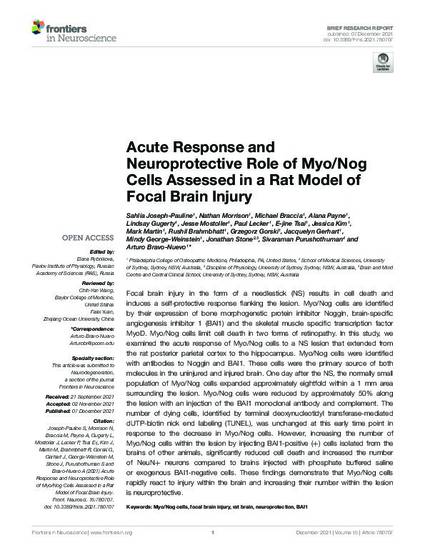
Focal brain injury in the form of a needlestick (NS) results in cell death and induces a self-protective response flanking the lesion. Myo/Nog cells are identified by their expression of bone morphogenetic protein inhibitor Noggin, brain-specific angiogenesis inhibitor 1 (BAI1) and the skeletal muscle specific transcription factor MyoD. Myo/Nog cells limit cell death in two forms of retinopathy. In this study, we examined the acute response of Myo/Nog cells to a NS lesion that extended from the rat posterior parietal cortex to the hippocampus. Myo/Nog cells were identified with antibodies to Noggin and BAI1. These cells were the primary source of both molecules in the uninjured and injured brain. One day after the NS, the normally small population of Myo/Nog cells expanded approximately eightfold within a 1 mm area surrounding the lesion. Myo/Nog cells were reduced by approximately 50% along the lesion with an injection of the BAI1 monoclonal antibody and complement. The number of dying cells, identified by terminal deoxynucleotidyl transferase-mediated dUTP-biotin nick end labeling (TUNEL), was unchanged at this early time point in response to the decrease in Myo/Nog cells. However, increasing the number of Myo/Nog cells within the lesion by injecting BAI1-positive (+) cells isolated from the brains of other animals, significantly reduced cell death and increased the number of NeuN+ neurons compared to brains injected with phosphate buffered saline or exogenous BAI1-negative cells. These findings demonstrate that Myo/Nog cells rapidly react to injury within the brain and increasing their number within the lesion is neuroprotective.
Available at: http://works.bepress.com/jacquelyn-gerhart/56/

This article was published in Frontiers in Neuroscience, Volume 15.
The published version is available at https://doi.org/10.3389/fnins.2021.780707.
Copyright © 2021 Joseph-Pauline, Morrison, Braccia, Payne, Gugerty, Mostoller, Lecker, Tsai, Kim, Martin, Brahmbhatt, Gorski, Gerhart, George-Weinstein, Stone, Purushothuman and Bravo-Nuevo. CC BY 4.0.